Cementitious Composites Reinforced with Waste Fibres from the Production of High-Quality Construction Textiles
Abstract
:1. Introduction
2. Materials and Methods
2.1. Waste Fibres from the Production of High-Performance Textiles
2.2. Mix Design and Curing
2.3. Methods
Toughness
3. Results and Discussions
3.1. Fresh State Properties of Mortar
3.2. Hardened Properties of Mortar
3.2.1. Compressive and Flexural Strength
3.2.2. Toughness
3.2.3. Volumetric Deformations of Mortar
4. Conclusions
- –
- The presence of fibres has a negative influence on the workability of the mortar irrespective of the type and length of fibres.
- –
- The type and length of fibres studied have a negligible effect on the compressive strength but lead to an average increase in flexural strength of 11 and 15% for basalt and carbon fibre reinforced mortars of both lengths, respectively, compared to the reference mixture. Glass fibres did not make any significant contribution.
- –
- The analysis of specific energy absorption capacity confirms a significant contribution of carbon fibres, showing an increase of 100 and 263 for fibres with length of 5 and 10 mm, respectively, compared to the reference mixture. Higher reinforcement index provides further increase in specific energy absorption capacity by 17, 28 and 263% for glass, basalt, and carbon fibres with length of 10 mm compared to shorter fibres.
- –
- The total shrinkage values are reduced for longer fibres (10 mm), more significantly at early ages, i.e., up to 3 days. The contribution of fibres correlates with their elastic modulus and aspect ratio; an increase in both properties leads to lower volumetric deformations. For shorter fibres (5 mm), this contribution is not observed in the total shrinkage values.
Author Contributions
Funding
Institutional Review Board Statement
Informed Consent Statement
Data Availability Statement
Acknowledgments
Conflicts of Interest
References
- Croatian Parliament. Building Act NN 153/13 (125/19); Official Gazette of the Republic of Croatia: Zagreb, Croatia, 2019. [Google Scholar]
- Mehta, B.Y.P.K.; Burrows, R.W. Building Durable Structures in the 21st Century. Concr. Int. 2001, 23, 57–63. [Google Scholar]
- Kennedy, C.; Corfee-Morlot, J. Past performance and future needs for low carbon climate resilient infrastructure—An investment perspective. Energy Policy 2013, 59, 773–783. [Google Scholar] [CrossRef]
- Vecchio, F.J.; Bucci, F. Analysis of Repaired Reinforced Concrete Structures. J. Struct. Eng. 1999, 125, 644–652. [Google Scholar] [CrossRef]
- Čunko, R.; Andrassy, M. Vlakna; Zrinski: Zagreb, Croatia, 2005. [Google Scholar]
- Haramina, T.; Jelavić, T.; Šolić, T.; Katalinić, M.; Pilipović, A. Analiza mogućnosti recikliranja diskontinuiranih E-staklenih vlakana. Polimeri 2011, 32, 64–73. [Google Scholar]
- UN General Assembly. Transforming Our World: The 2030 Agenda for Sustainable Development; United Nations: New York, NY, USA, 2015. [Google Scholar]
- European Parliament. Regulation (EU) No 305/2011 of the European parliament and of the council of 9 March 2011 laying down harmonized conditions for the marketing of construction products and repealing Council Directive 89/106/EEC. Off. J. Eur. Union 2011, 5–43. [Google Scholar]
- Akbar, A.; Liew, K.M. Multicriteria performance evaluation of fiber-reinforced cement composites: An environmental perspective. Compos. Part B Eng. 2021, 218, 108937. [Google Scholar] [CrossRef]
- Ministry of Environmental Protection and Energy, Environmental and Nature Institute. Methodology for the Implementation of Energy Audits for Buildings. 2021. Available online: https://mpgi.gov.hr/UserDocsImages//dokumenti/EnergetskaUcinkovitost//Metodologija-2021.pdf (accessed on 1 November 2021).
- Brandt, A.M. Fibre reinforced cement-based (FRC) composites after over 40 years of development in building and civil engineering. Compos. Struct. 2008, 86, 3–9. [Google Scholar] [CrossRef]
- Wang, X.; He, J.; Mosallam, A.S.; Li, C.; Xin, H. The Effects of Fiber Length and Volume on Material Properties and Crack Resistance of Basalt Fiber Reinforced Concrete (BFRC). Adv. Mater. Sci. Eng. 2019, 2019, 7520549. [Google Scholar] [CrossRef] [Green Version]
- Ahmad, W.; Khan, M. Effect of Short Fiber Reinforcements on Fracture Performance of Cement-Based Materials: A Systematic Review Approach. Materials 2021, 14, 1745. [Google Scholar] [CrossRef]
- Shaikh, F.U.A.; Luhar, S.; Arel, H.Ş.; Luhar, I. Performance evaluation of Ultrahigh performance fibre reinforced concrete—A review. Constr. Build. Mater. 2020, 232, 117152. [Google Scholar] [CrossRef]
- Bertelsen, I.M.G.; Ottosen, L.M.; Fischer, G. Influence of fibre characteristics on plastic shrinkage cracking in cement-based materials: A review. Constr. Build. Mater. 2020, 230, 116769. [Google Scholar] [CrossRef]
- Mohajerani, A.; Hui, S.Q.; Mirzababaei, M.; Arulrajah, A.; Horpibulsuk, S.; Kadir, A.A.; Rahman, M.T.; Maghool, F. Amazing types, properties, and applications of fibres in construction materials. Materials 2019, 12, 2513. [Google Scholar] [CrossRef] [PubMed] [Green Version]
- Meddah, M.S.; Bencheikh, M. Properties of concrete reinforced with different kinds of industrial waste fibre materials. Constr. Build. Mater. 2009, 23, 3196–3205. [Google Scholar] [CrossRef]
- Glass Fiber Reinforced Concrete (GFRC). Market by Process (Spray, Premix, and Hybrid), Application (Commercial Construction, Residential Construction and Civil & Other Infrastructure Construction), and Region—Global Forecast to 2023. Available online: https://www.marketsandmarkets.com/Market-Reports/glass-fiber-reinforced-concrete-market-190652223.html (accessed on 2 June 2020).
- Carbon Fiber Market by Raw Material (PAN, Pitch), Fiber Type (Virgin, Recycled), Product Type, Modulus, Application (Composite, Non-Composite), End-Use Industry (A & D, Automotive, Wind Energy) and Region—Global Forecast to 2031. Available online: https://www.marketsandmarkets.com/Market-Reports/carbon-fiber-396.html?gclid=EAIaIQobChMIoI24oKDJ5wIVFuDtCh0f-wPCEAAYASAAEgIyYfD_BwE/11/2/2020 (accessed on 2 November 2020).
- Basalt Fiber Market by Form (Continuous and Discrete), End-Use Industry (Construction & Infrastructure, Automotive & Transportation, Electrical & Electronics, Marine), Usage (Composites, Non-Composites), and Region—Global Forecast to 2024. Available online: https://www.marketsandmarkets.com/Market-Reports/basalt-fiber-market-39388070.html (accessed on 2 November 2020).
- Baricevic, A.; Jelcic Rukavina, M.; Francic Smrkic, M.; Carevic, I.; Didulica, K. Cementitious Composites Reinforced with Waste Fibres—ReWire (UIP-2020-02-5242), Installation Project Funded by Croatian Science Foundation. Available online: https://rewire.grad.hr/ (accessed on 1 December 2021).
- European Parliament. Directive 2008/98/EC of the European Parliament and of the Council of 19 November 2008 on waste and repealing certain Directives. Off. J. Eur. Union 2008, 34, 99–126. [Google Scholar]
- Mastali, M.; Dalvand, A.; Sattarifard, A.R. The impact resistance and mechanical properties of reinforced self-compacting concrete with recycled glass fibre reinforced polymers. J. Clean. Prod. 2016, 124, 312–324. [Google Scholar] [CrossRef]
- Mastali, M.; Abdollahnejad, Z.; Dalvand, A.; Sattarifard, A.; Illikainen, M. Comparative effects of using recycled CFRP and GFRP fibers on fresh- and hardened-state properties of self-compacting concretes: A review. In New Materials in Civil Engineering; Elsevier: Amsterdam, The Netherlands, 2020; pp. 643–655. [Google Scholar]
- Nguyen, H.; Fujii, T.; Okubo, K.; Carvelli, V. Cement mortar reinforced with recycled carbon fiber and CFRP waste. In Proceedings of the ECCM 2016—17th European Conference on Composite Materials, Munich, Germany, 26–30 June 2016. [Google Scholar]
- Dehghan, A.; Peterson, K.; Shvarzman, A. Recycled glass fiber reinforced polymer additions to Portland cement concrete. Constr. Build. Mater. 2017, 146, 238–250. [Google Scholar] [CrossRef]
- Kimm, M.; Pico, D.; Gries, T. Investigation of surface modification and volume content of glass and carbon fibres from fibre reinforced polymer waste for reinforcing concrete. J. Hazard. Mater. 2020, 390, 121797. [Google Scholar] [CrossRef]
- Ou, Y.-C.; Tsai, M.-S.; Liu, K.-Y.; Chang, K.-C. Compressive Behavior of Steel-Fiber-Reinforced Concrete with a High Reinforcing Index. J. Mater. Civ. Eng. 2012, 24, 207–215. [Google Scholar] [CrossRef]
- Poletanovic, B.; Dragas, J.; Ignjatovic, I.; Komljenovic, M.; Merta, I. Physical and mechanical properties of hemp fibre reinforced alkali-activated fly ash and fly ash/slag mortars. Constr. Build. Mater. 2020, 259, 119677. [Google Scholar] [CrossRef]
- Zhu, H.; Zhou, H.; Gou, H. Evaluation of carbon fiber dispersion in cement-based materials using mechanical properties, conductivity, mass variation coefficient, and microstructure. Constr. Build. Mater. 2021, 266, 120891. [Google Scholar] [CrossRef]
- Lee, S.F.; Jacobsen, S. Study of interfacial microstructure, fracture energy, compressive energy and debonding load of steel fiber-reinforced mortar. Mater. Struct. 2011, 44, 1451–1465. [Google Scholar] [CrossRef] [Green Version]
- Panzera, T.H.; Christoforo, A.L.; Ribeiro Borges, P.H. High performance fibre-reinforced concrete (FRC) for civil engineering applications. In Advanced Fibre-Reinforced Polymer (FRP) Composites for Structural Applications; Elsevier Ltd.: Amsterdam, The Netherlands, 2013; pp. 552–581. ISBN 9780857094186. [Google Scholar]
- Mastali, M.; Dalvand, A.; Sattarifard, A. The impact resistance and mechanical properties of the reinforced self-compacting concrete incorporating recycled CFRP fiber with different lengths and dosages. Compos. Part B Eng. 2017, 112, 74–92. [Google Scholar] [CrossRef]
- He, S.; Li, Z.; Yang, E.H. Quantitative characterization of anisotropic properties of the interfacial transition zone (ITZ)between microfiber and cement paste. Cem. Concr. Res. 2019, 122, 136–146. [Google Scholar] [CrossRef]
- Wang, W.; Shen, A.; Lyu, Z.; He, Z.; Nguyen, K.T.Q. Fresh and rheological characteristics of fiber reinforced concrete—A review. Constr. Build. Mater. 2021, 296, 123734. [Google Scholar] [CrossRef]
- EN 1015-3:1999/A1:2004/A2:2006 CSI:HRN EN 1015-3:2000; Methods of Test for Mortar for Masonry—Part 3: Determination of Consistence of Fresh Mortar (by Flow Table); Croatian Standard Institute: Zagreb, Croatia, 2008.
- ACI Committee 544 Report on the Physical Properties and Durability of Fiber-Reinforced Concrete; American Concrete Institute: Farmington Hills, MI, USA, 2010; ISBN 9780870313653.
- Safiuddin, M.; Yakhlaf, M.; Soudki, K.A. Key mechanical properties and microstructure of carbon fibre reinforced self-consolidating concrete. Constr. Build. Mater. 2018, 164, 477–488. [Google Scholar] [CrossRef]
- Mazzoli, A.; Monosi, S.; Plescia, E.S. Evaluation of the early-age-shrinkage of Fiber Reinforced Concrete (FRC) using image analysis methods. Constr. Build. Mater. 2015, 101, 596–601. [Google Scholar] [CrossRef]
- Daniel, J.I.; Ahmad, S.H.; Arockiasamy, M.; Ball, H.P. State-of-the-art report on fiber reinforced concrete reported by ACI Committee 544. ACI J. 2002, 96, 1–66. [Google Scholar]
- Serna, P.; Llano-Torre, A.; Martí-Vargas, J.R.; Navarro-Gregori, J. Fibre Reinforced Concrete: Improvements and Innovations II: X RILEM-Fib International Symposium on Fibre Reinforced Concrete (BEFIB) 2021; Springer: Cham, Switzerland, 2022; Volume 36, p. 979. [Google Scholar]
- Mahmood Raouf, R.; Meerza Al Jaaf, H.J.; Nasser, I.F. Determine the influence of fiber types on some properties of self-compacted mortar. Mater. Today Proc. 2021, 42, 1951–1957. [Google Scholar] [CrossRef]
- Gull, I.; Tantray, M.A. Effect of Super Plasticizers on Fresh and Hardened State Properties of Short Carbon Fiber Reinforced Electrically Conductive Concrete. Int. J. Recent Technol. Eng. 2020, 8, 2277–3878. [Google Scholar]
- Algin, Z.; Ozen, M. The properties of chopped basalt fibre reinforced self-compacting concrete. Constr. Build. Mater. 2018, 186, 678–685. [Google Scholar] [CrossRef]
- Chung, D.D. Dispersion of Short Fibers in Cement. J. Mater. Civ. Eng. 2005, 17, 379–383. [Google Scholar] [CrossRef]
- Cao, J.; Chung, D.D.L. Improving the dispersion of steel fibers in cement mortar by the addition of silane. Cem. Concr. Res. 2001, 31, 309–311. [Google Scholar] [CrossRef]
- Micelli, F.; Renni, A.; Kandalaft, A.G.; Moro, S. Fiber-reinforced concrete and ultrahigh-performance fiber-reinforced concrete materials. In New Materials in Civil Engineering; Elsevier: Amsterdam, The Netherlands, 2020; pp. 273–314. [Google Scholar]
- Kizilkanat, A.B. Experimental evaluation of mechanical properties and fracture behavior of carbon fiber reinforced high strength concrete. Period. Polytech. Civ. Eng. 2016, 60, 289–296. [Google Scholar] [CrossRef] [Green Version]
- Kizilkanat, A.B.; Kabay, N.; Akyüncü, V.; Chowdhury, S.; Akça, A.H. Mechanical properties and fracture behavior of basalt and glass fiber reinforced concrete: An experimental study. Constr. Build. Mater. 2015, 100, 218–224. [Google Scholar] [CrossRef]
- Fenu, L.; Forni, D.; Cadoni, E. Dynamic behaviour of cement mortars reinforced with glass and basalt fibres. Compos. Part B Eng. 2016, 92, 142–150. [Google Scholar] [CrossRef]
- Fenu, L.; Forni, D.; Cadoni, E. Energy absorption at high strain rate of glass fiber reinforced mortars. EPJ Web Conf. 2015, 94, 2–6. [Google Scholar] [CrossRef] [Green Version]
- Coppola, L.; Cadoni, E.; Forni, D.; Buoso, A. Mechanical characterization of cement composites reinforced with fiberglass, carbon nanotubes or glass reinforced plastic (GRP) at high strain rates. Appl. Mech. Mater. 2011, 82, 190–195. [Google Scholar] [CrossRef] [Green Version]
- Li, Y.F.; Lee, K.F.; Ramanathan, G.K.; Cheng, T.W.; Huang, C.H.; Tsai, Y.K. Static and dynamic performances of chopped carbon-fiberreinforced mortar and concrete incorporated with disparate lengths. Materials 2021, 14, 972. [Google Scholar] [CrossRef]
- Saffiudin, M. High-Performance Mortar Reinforced with Short Carbon Fibers. Master’s Thesis, University of Windsor, Civil and Environmental Engineering, Windsor, ON, Canada, 2003. [Google Scholar]
- Saradar, A.; Tahmouresi, B.; Mohseni, E.; Shadmani, A. Restrained shrinkage cracking of fiber-reinforced high-strength. Fibers 2018, 6, 12. [Google Scholar] [CrossRef] [Green Version]
- Muleyp, P.; Varpep, S.; Ralwanip, R. Chopped Carbon Fibers Innovative Material for Enhancement of Concrete Performances. Int. J. Sci. Eng. Appl. Sci. 2015, 1, 2395–3470. [Google Scholar]
- Wongtanakitcharoen, T.; Naaman, A.E. Unrestrained early age shrinkage of concrete with polypropylene, PVA, and carbon fibers. Mater. Struct. 2007, 40, 289–300. [Google Scholar] [CrossRef]
- Ruijie, M.A.; Yang, J.; Liu, Y.; Zheng, X. Influence of length-to-diameter ratio on shrinkage of basalt fiber concrete. IOP Conf. Ser. Mater. Sci. Eng. 2017, 242, 12027. [Google Scholar] [CrossRef] [Green Version]
- Mindess, S. Developments in the Formulation and Reinforcement of Concrete, 1st ed.; Woodhead Publishing: Cambridge, UK, 2008; ISBN 9781845692636. [Google Scholar]
- Junior, M.S.D.O.; Diniz, M.F.; Dutra, R.D.C.L.; Massi, M.; Otani, C. Applicability of FT-IR techniques and goniometry on characterization of carbon fiber surfaces. J. Aerosp. Technol. Manag. 2016, 8, 26–32. [Google Scholar] [CrossRef]
- Zhang, T.; Zhao, Y.; Li, H.; Zhang, B. Effect of polyurethane sizing on carbon fibers surface and interfacial adhesion of fiber/polyamide 6 composites. J. Appl. Polym. Sci. 2017, 135, 46111. [Google Scholar] [CrossRef]
- Yang, T.; Zhao, Y.; Liu, H.; Sun, M.; Xiong, S. Effect of Sizing Agents on Surface Properties of Carbon Fibers and Interfacial Adhesion of Carbon Fiber/Bismaleimide Composites. ACS Omega 2021, 6, 23028–23037. [Google Scholar] [CrossRef] [PubMed]
- Kawashima, S.; Shah, S.P. Early-age autogenous and drying shrinkage behavior of cellulose fiber-reinforced cementitious materials. Cem. Concr. Compos. 2011, 33, 201–208. [Google Scholar] [CrossRef] [Green Version]
- Zhang, J.; Li, V.C. Influences of Fibers on Drying Shrinkage of Fiber-Reinforced Cementitious Composite. J. Eng. Mech. 2001, 127, 37–44. [Google Scholar] [CrossRef] [Green Version]
- Didulica, K.; Baričević, A.; Frančić Smrkić, M.; Jelčić Rukavina, M. Preliminary study on the influence of waste fibres on early age autogenous shrinkage of cementitious composites. In Proceedings of the 15th International Conference on Planning, Design, Construction and Building Renewal (iNDiS 2021), Novi Sad, Serbia, 24–26 September 2021. [Google Scholar]

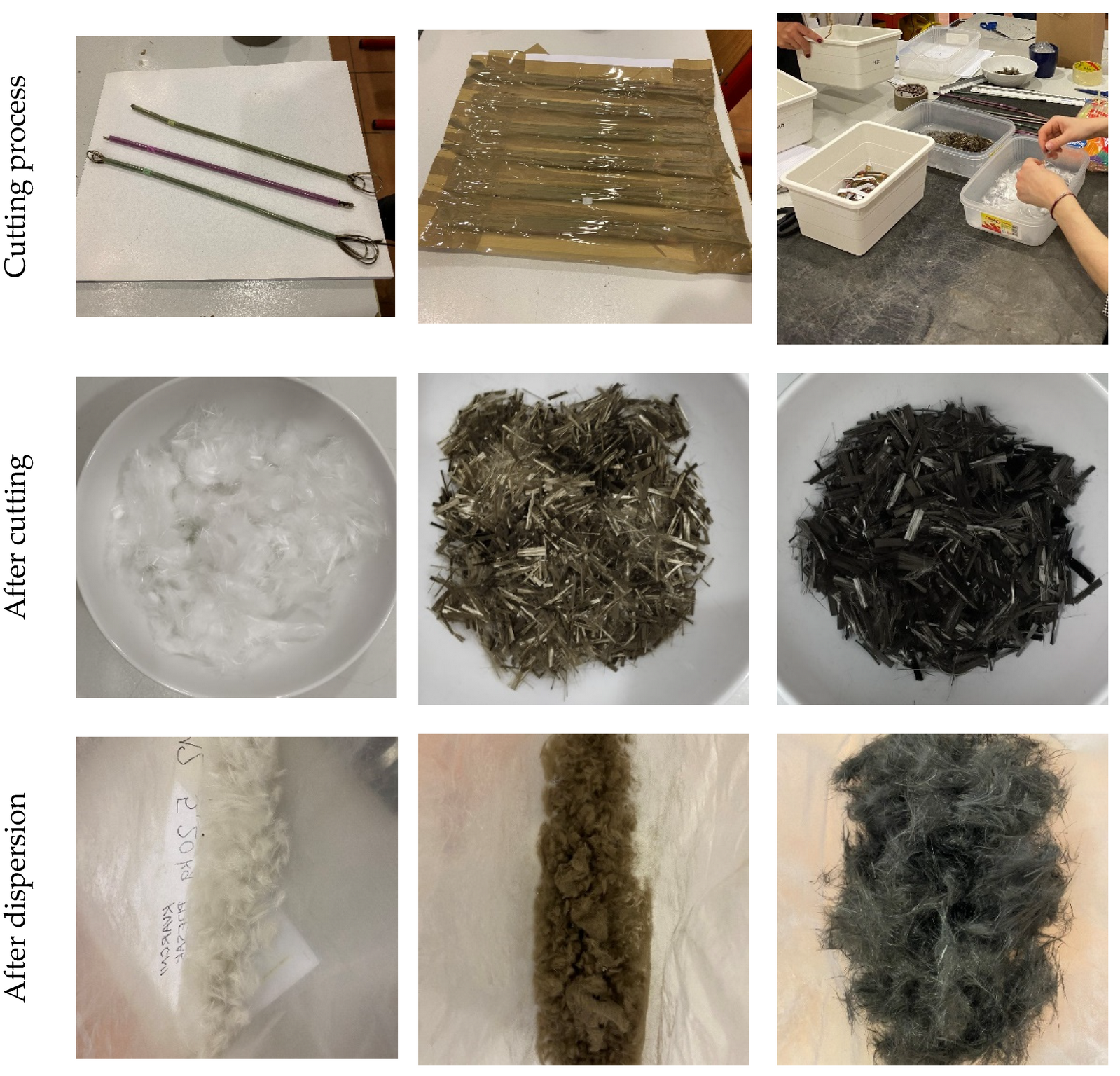
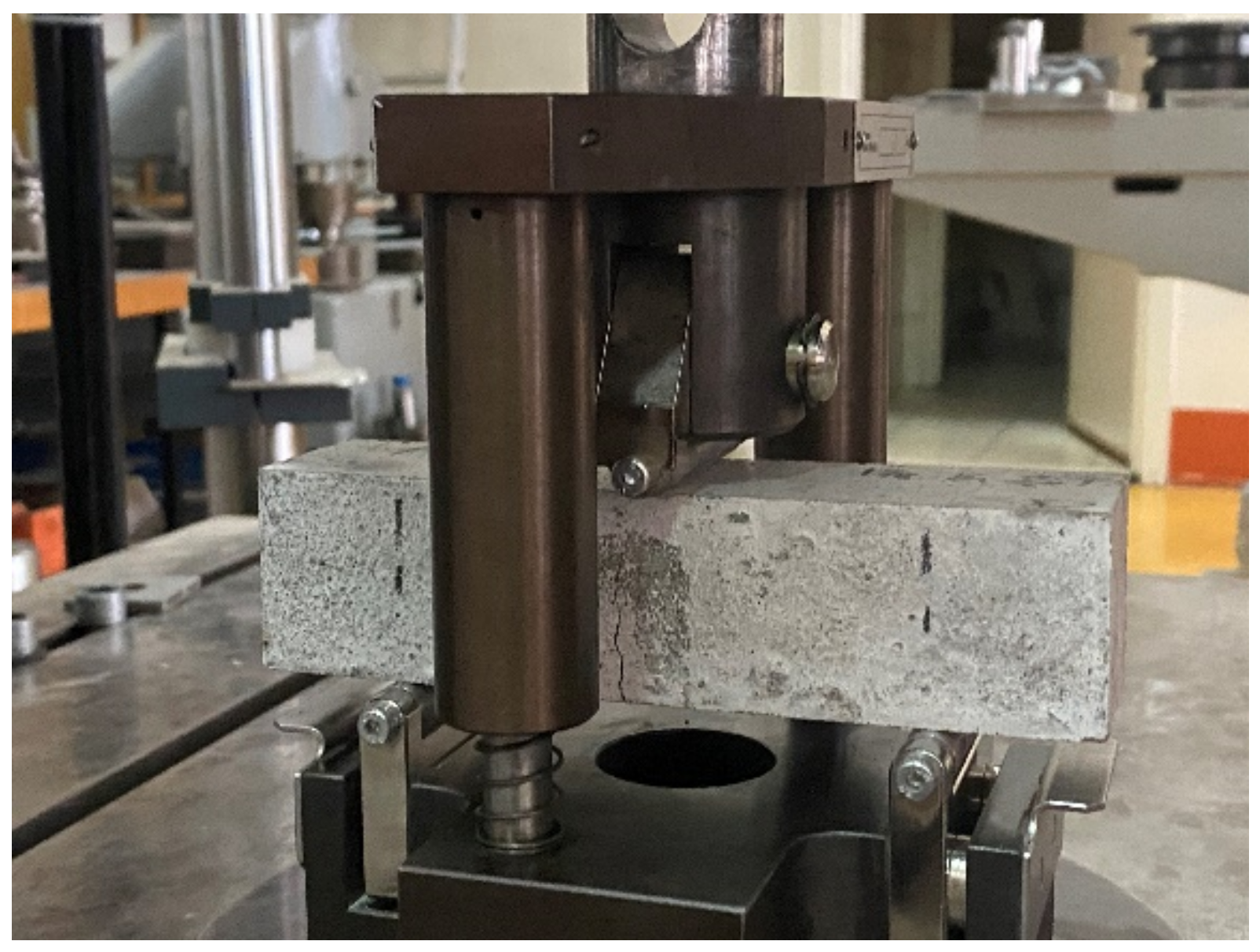

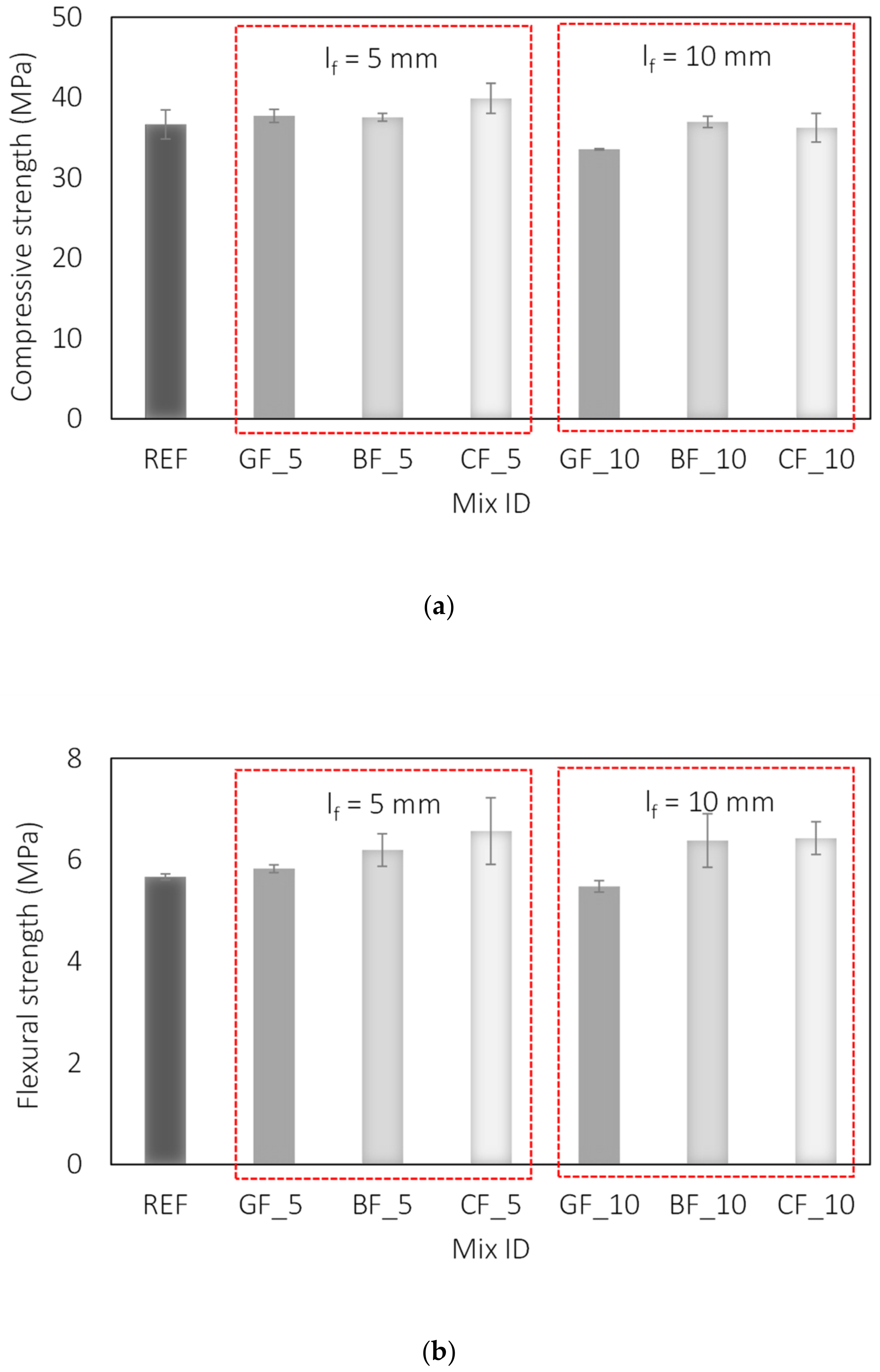

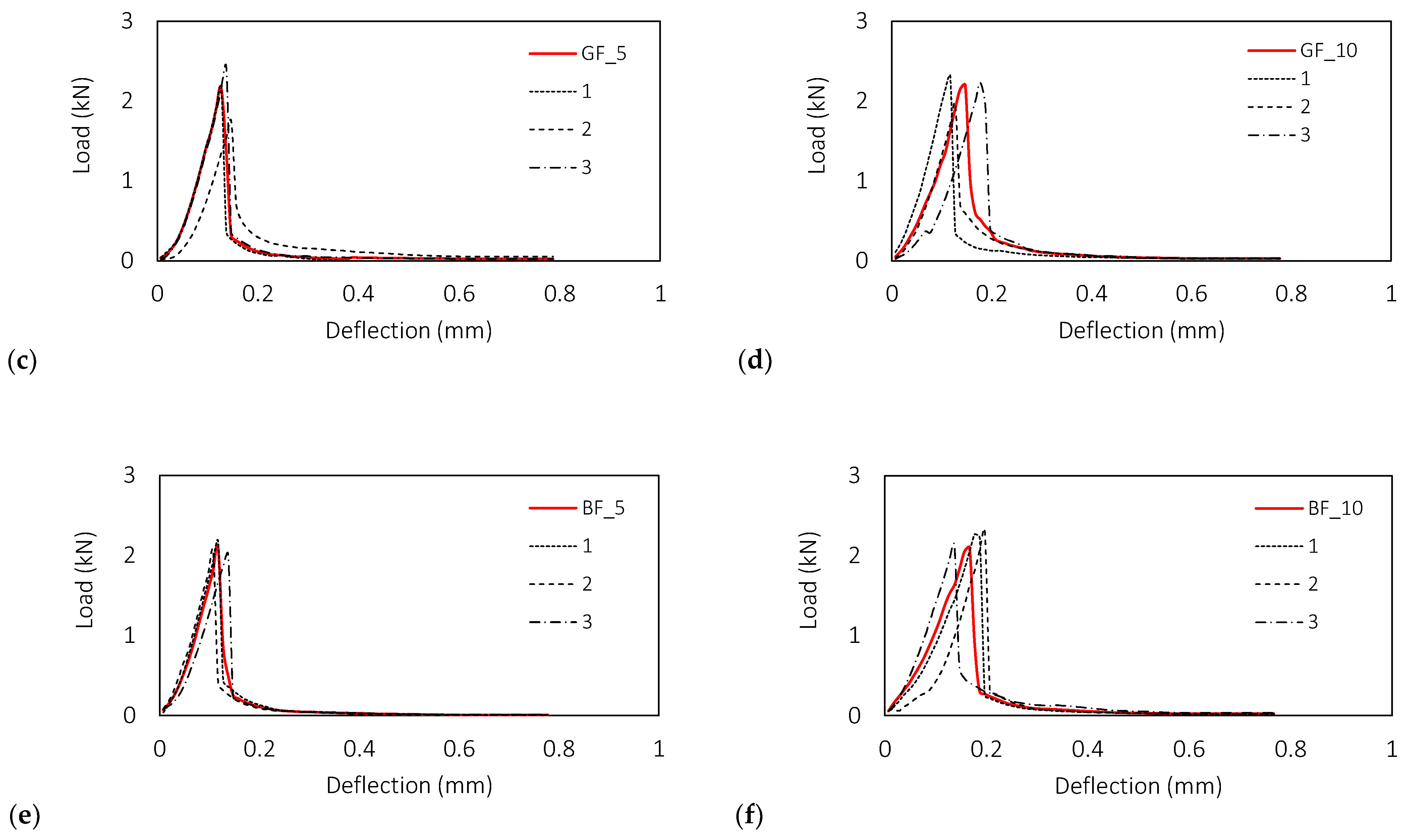



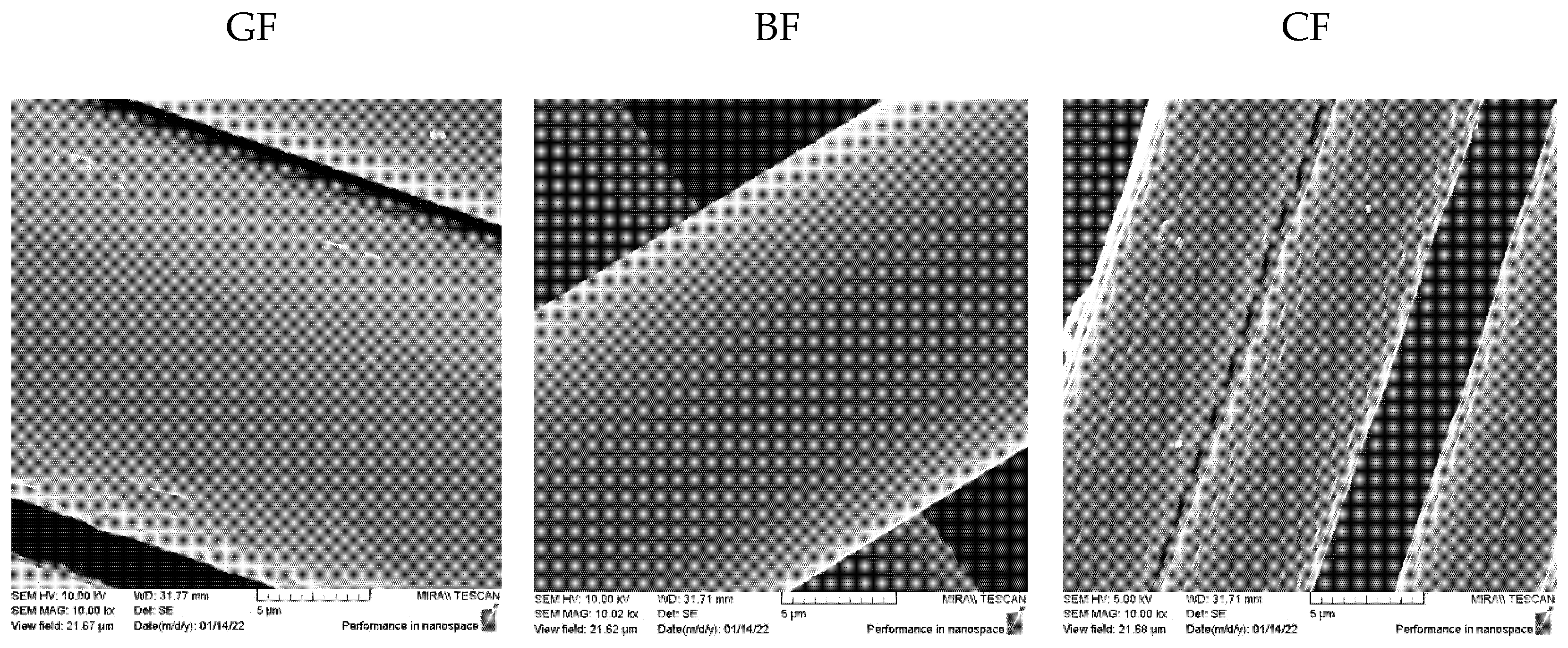
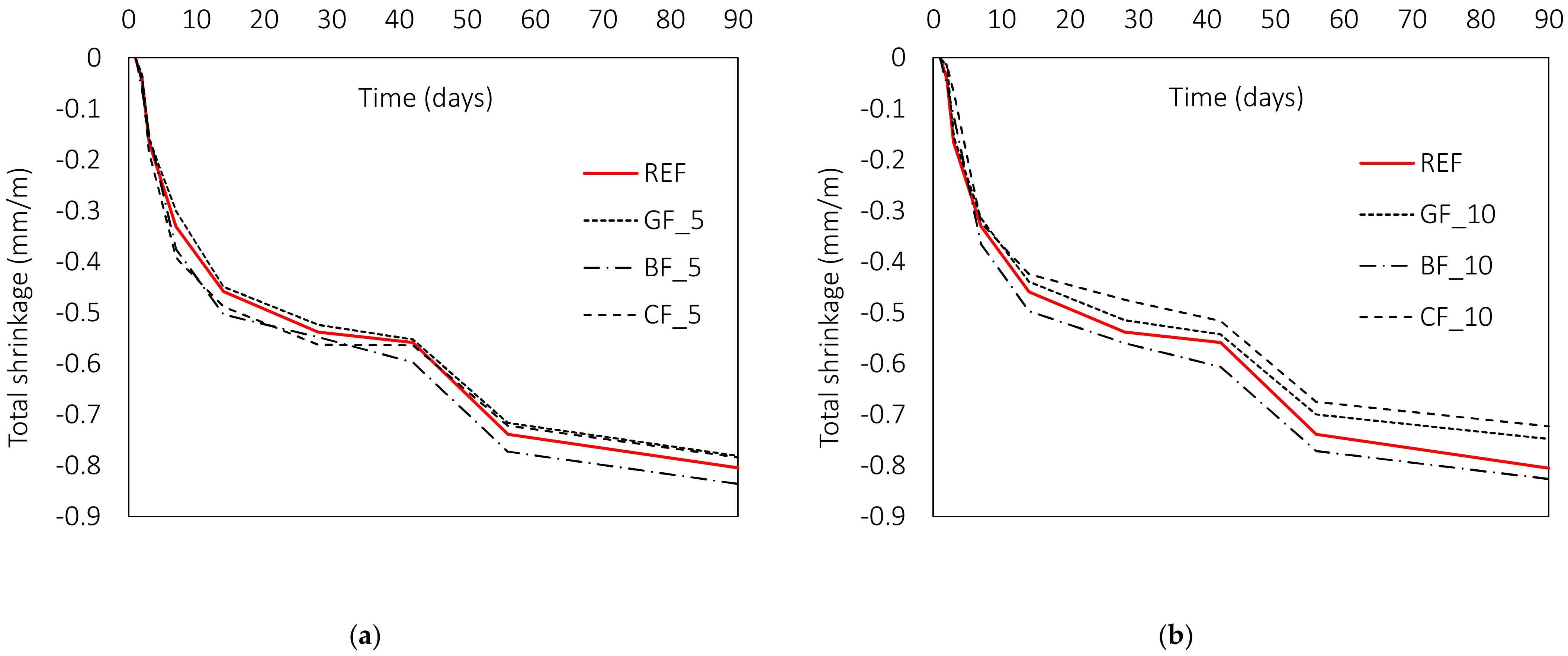
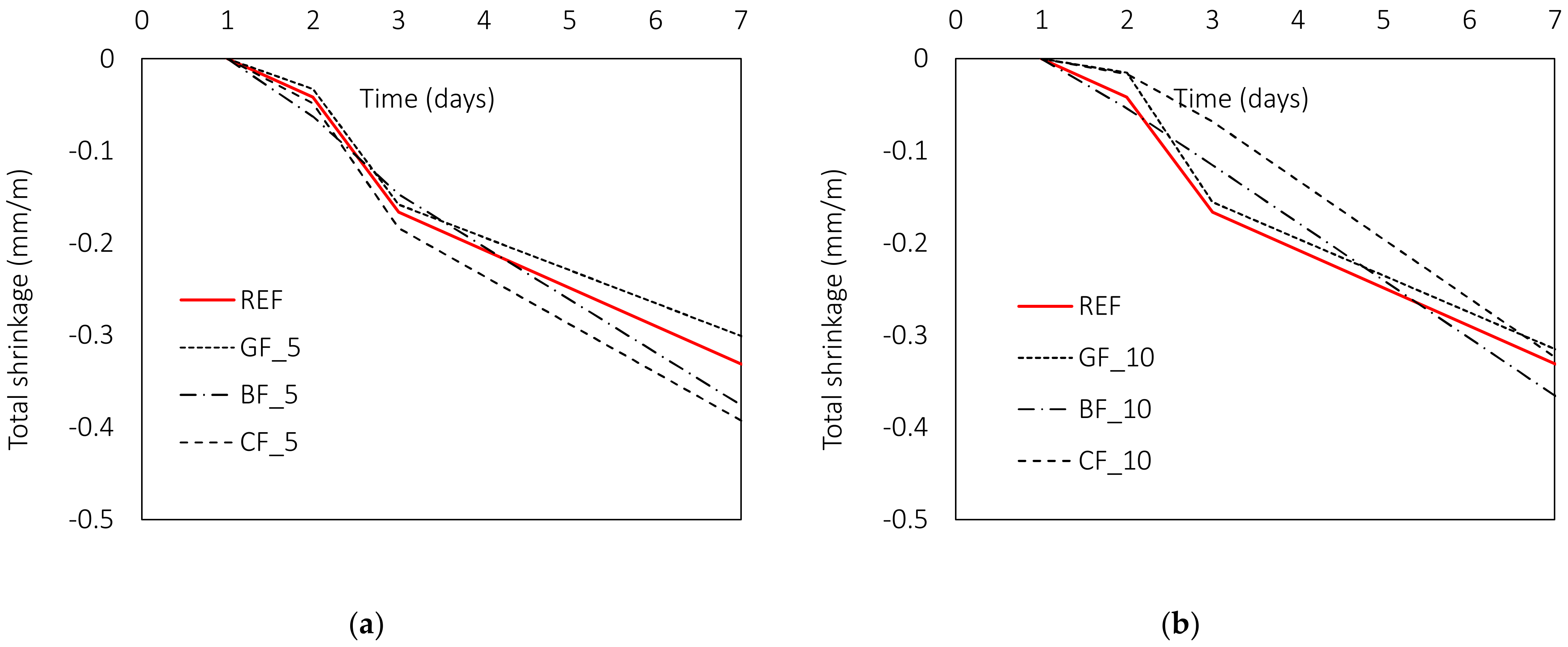

| Fibre ID | Filament Diameter [µm] | No. of Filaments in Yarn | Linear Density [tex] | Tensile Strength of Yarn [MPa] | Modulus of Elasticity of Yarn [GPa] | Sizing |
|---|---|---|---|---|---|---|
| Alkali-resistant glass (GF) | 20 | 1500 | 1200 | 1000–1700 | 72 | silane |
| Basalt (BF) | 17 | 1000 | 600 | 2900–3100 | 86 | silane |
| Carbon (CF) | 7 | 47,000 | 3200 | 4300 | 250 | PU |
| Fibre Property | Fibre Type | |||||
|---|---|---|---|---|---|---|
| * lf = 5 mm | lf = 10 mm | |||||
| GF_5 | BF_5 | CF_5 | GF_10 | BF_10 | CF_10 | |
| Aspect ratio | 250 | 294 | 714 | 500 | 588 | 1429 |
| Reinforcement index | 0.5 | 0.6 | 2.1 | 1.0 | 1.2 | 4.3 |
| Number of fibres per mm2 | 1.27 | 1.76 | 15.60 | 0.64 | 0.88 | 7.80 |
| Specific fibre surface | 0.40 | 0.47 | 1.71 | 0.40 | 0.47 | 1.71 |
| Property | REF | lf = 5 mm | lf = 10 mm | ||||
|---|---|---|---|---|---|---|---|
| GF_5 | BF_5 | CF_5 | GF_10 | BF_10 | CF_10 | ||
| Superplasticizer [% per mc] | 0.40 | 0.40 | 0.45 | 0.65 | 0.45 | 0.45 | 0.65 |
| Property | Standard | Number of Specimens per Mixture |
|---|---|---|
| Density | EN 1015-6:2000/A1:2008 | - |
| Air content | EN 1015-7:2000 | |
| Consistency by flow table | EN 1015-3:2000/A1:2005/A2:2008 | |
| Compressive strength | EN 196-1:2016 | 6 |
| Flexural strength | EN 196-1:2016 | 3 |
| Total shrinkage | EN 12390-16 | 3 |
| Toughness | - | 6 |
| Property | REF | lf = 5 mm | lf = 10 mm | ||||
|---|---|---|---|---|---|---|---|
| GF_5 | BF_5 | CF_5 | GF_10 | BF_10 | CF_10 | ||
| Density [g/cm3] | 1833 | 1910 | 1991 | 2009 | 1909 | 1989 | 1971 |
| Flow table raverage [mm] | 156 | 135 | 116 | 119 | 133 | 115 | 111 |
| Air content [%] | 16.0 | 13.0 | 9.5 | 10.0 | 14.0 | 8.5 | 9.7 |
| Load Level | REF | lf = 5 mm | lf = 10 mm | ||||
|---|---|---|---|---|---|---|---|
| GF_5 | BF_5 | CF_5 | GF_10 | BF_10 | CF_10 | ||
| Fmax (kN) | 2.28 ± 0.19 | 2.15 ± 0.3 | 2.15 ± 0.11 | 2.44 ± 0.07 | 2.20 ± 0.19 | 2.31 ± 0.11 | 2.44 ± 0.19 |
| F0,2 (kN) | 0.14 ± 0.11 | 0.17 ± 0.11 | 0.11 ± 0.02 | 0.76 ± 0.38 | 0.26 ± 0.12 | 0.30 ± 0.07 | 1.61 ± 0.52 |
| F0,3 (kN) | 0.06 ± 0.03 | 0.08 ± 0.07 | 0.04 ± 0.0 | 0.35 ± 0.08 | 0.10 ± 0.03 | 0.10 ± 0.03 | 0.95 ± 0.50 |
| F0,4 (kN) | 0.04 ± 0.02 | 0.05 ± 0.06 | 0.03 ± 0.01 | 0.24 ± 0.06 | 0.06 ± 0.01 | 0.06 ± 0.03 | 0.65 ± 0.57 |
Publisher’s Note: MDPI stays neutral with regard to jurisdictional claims in published maps and institutional affiliations. |
© 2022 by the authors. Licensee MDPI, Basel, Switzerland. This article is an open access article distributed under the terms and conditions of the Creative Commons Attribution (CC BY) license (https://creativecommons.org/licenses/by/4.0/).
Share and Cite
Baričević, A.; Didulica, K.; Frančić Smrkić, M.; Jelčić Rukavina, M. Cementitious Composites Reinforced with Waste Fibres from the Production of High-Quality Construction Textiles. Materials 2022, 15, 1611. https://doi.org/10.3390/ma15041611
Baričević A, Didulica K, Frančić Smrkić M, Jelčić Rukavina M. Cementitious Composites Reinforced with Waste Fibres from the Production of High-Quality Construction Textiles. Materials. 2022; 15(4):1611. https://doi.org/10.3390/ma15041611
Chicago/Turabian StyleBaričević, Ana, Katarina Didulica, Marina Frančić Smrkić, and Marija Jelčić Rukavina. 2022. "Cementitious Composites Reinforced with Waste Fibres from the Production of High-Quality Construction Textiles" Materials 15, no. 4: 1611. https://doi.org/10.3390/ma15041611
APA StyleBaričević, A., Didulica, K., Frančić Smrkić, M., & Jelčić Rukavina, M. (2022). Cementitious Composites Reinforced with Waste Fibres from the Production of High-Quality Construction Textiles. Materials, 15(4), 1611. https://doi.org/10.3390/ma15041611







